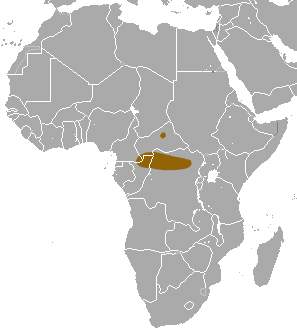
The white-toothed shrews or Crocidurinae are one of three subfamilies of the shrew family Soricidae.

The charming thicket rat is a species of rodent in the family Muridae. It is described as data deficient as Thamnomys schoutedeni. It is found in Democratic Republic of the Congo, Rwanda, and Uganda. Its natural habitat is subtropical or tropical moist montane forests. It is threatened by habitat loss.

The African dusky shrew or African foggy shrew is a species of shrew. It is native to the Democratic Republic of the Congo, where it lives in forests.

The long-footed shrew is a species of mammal in the family Soricidae. It is found in Cameroon, Central African Republic, Republic of the Congo, Democratic Republic of the Congo, Equatorial Guinea, and Gabon. Its natural habitat is subtropical or tropical moist lowland forests.

The savanna shrew is a species of mammal in the family Soricidae. It is found in Benin, Burkina Faso, Cameroon, Central African Republic, Chad, Democratic Republic of the Congo, Djibouti, Eritrea, Ethiopia, Kenya, Mali, Mauritania, Niger, Nigeria, Sudan, and Uganda. Its natural habitat is dry savanna.

Latona's shrew is a species of shrew in the genus Crocidura. It is endemic to Democratic Republic of the Congo. Its natural habitat is subtropical or tropical moist lowland forests.

The Butiaba naked-tailed shrew is a species of mammal in the family Soricidae. It is found in Cameroon, Central African Republic, Republic of the Congo, Democratic Republic of the Congo, Kenya, and Uganda. Its natural habitat is subtropical or tropical moist lowland forests.

Ludia's shrew is a species of mammal in the family Soricidae. It is found in Cameroon, Central African Republic, Republic of the Congo, and Democratic Republic of the Congo. Its natural habitat is subtropical or tropical moist lowland forests.

The flat-headed shrew is a species of mammal in the family Soricidae. It is found in the Democratic Republic of the Congo, Ethiopia, Nigeria, and Uganda. The flat-headed shrew is listed as Data Deficient on the IUCN Red List of Threatened Species.

The turbo shrew is a species of mammal in the family Soricidae. It is found in Angola, Burundi, Cameroon, Central African Republic, Republic of the Congo, Democratic Republic of the Congo, Equatorial Guinea, Gabon, Kenya, Malawi, Rwanda, South Sudan, Tanzania, Uganda, and Zambia. Its natural habitats are subtropical or tropical moist lowland and montane forests.

The Upemba shrew is a species of shrew in the family Soricidae. It is endemic to Democratic Republic of the Congo. Its natural habitat is swamp.

Grauer's large-headed shrew is a species of mammal in the family Soricidae. It is endemic to the Democratic Republic of the Congo. Its natural habitat is subtropical or tropical moist montane forests.
Paracrocidura is a genus of shrews. They are mammals in the family Soricidae. The vernacular name large-headed shrews is sometimes collectively applied to the genus, but has also been applied to the species Crocidura grandiceps.

The greater large-headed shrew is a species of mammal in the family Soricidae. It is found in Burundi, Democratic Republic of the Congo, Rwanda, and Uganda. Its natural habitats are subtropical or tropical moist lowland and montane forests, and swamps.

Synodontis schoutedeni, known as the yellow marbled Synodontis, is a species of upside-down catfish native to the Congo Basin of the Democratic Republic of the Congo and the Republic of the Congo. It was first described by Belgian ichthyologist Lore Rose David in 1936, based upon a holotype discovered in Basongo, in what is now the Democratic Republic of the Congo. The specific name "schoutedeni" is named after the Belgian zoologist Henri Schouteden.
Clupeocharax schoutedeni is a species of African tetra endemic to the Democratic Republic of Congo.
Henri Schouteden was a Belgian zoologist, ornithologist and entomologist who undertook numerous expeditions into the Congo, Rwanda, and Burundi.















